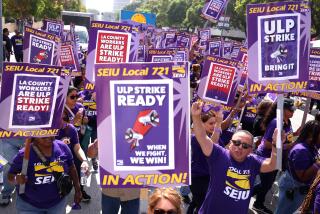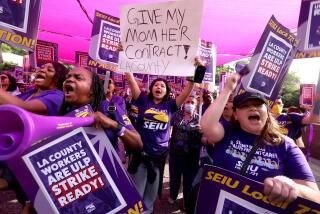Local Unions Vow to Continue Movement
Galvanized by the fight against Gov. Arnold Schwarzenegger and strengthened by a decade of organizing success, Southern California union leaders promised Monday they would find ways to keep the regional labor movement working together despite the split of the national AFL-CIO.
But doing so could pose considerable challenges to union officials, who have built the Los Angeles labor movement into one of the region’s most formidable political forces.
The departure of the Service Employees International Union, which is the Los Angeles County Federation of Labor’s largest member, could cost the state and local labor federations a third of their annual budgets, complicating their ability to mount political campaigns.
At the same time, maintaining political clout in the face of the national schism might require some deft organizational work from local and state union leaders in the coming weeks and months.
With a ballot fight against several Schwarzenegger-backed initiatives looming this fall, unions have little incentive to part ways in Los Angeles or in California. And several political observers predicted that labor would continue to exert a strong influence.
“My guess is that we’re not going to see anything too dramatic,” said veteran Democratic political consultant Bill Carrick, who has worked with Sen. Dianne Feinstein (D-Calif.) and former Los Angeles Mayor James K. Hahn. “Labor will still be allied on its basic agenda
Several of the state’s leading unions are independent from the county federation, including the California Teachers Assn.
The SEIU and the International Brotherhood of Teamsters left the national AFL-CIO over the weekend. The United Food and Commercial Workers and Unite Here, which represents garment and hotel workers, are threatening to disaffiliate as well.
But Martin Ludlow, who was just elected to head the influential Los Angeles federation, and California Labor Federation leader Art Pulaski talked optimistically about the future.
“The local labor movement is going to be strengthened by the need to be even more aggressive,” Ludlow said from Chicago, where he was meeting with national labor leaders.
The Los Angeles County federation currently comprises 357 unions representing more than 800,000 workers.
Several leaders of SEIU locals also said Monday that they intended to remain part of the county federation, despite the national split.
“Our disaffiliation does not diminish our commitment to the local federation,” said SEIU Local 434B President Tyrone Freeman, who heads the largest local in Southern California representing home care workers.
But whether national AFL-CIO officials would allow a union to split with the federation on the national level but remain affiliated locally remains unclear.
Before he died earlier this year, Miguel Contreras, the head of the county federation, was working to devise a new umbrella organization that could keep the SEIU and the county federation together in the event of a national split. Several local SEIU members said they would support such a move if they were forced to leave the county federation.
Ludlow said Monday it was too early to talk about such a move. “The dust hasn’t settled yet,” he said.
Schwarzenegger has provided a major incentive for the unions to remain together.
Labor officials are gearing up for a fight with the governor in November in what is shaping up to be something of a clash of state political titans.
The governor has taken aim at the powerful state teachers union by championing a measure to increase tenure requirements for California public school teachers.
And unions see him striking a blow directly at the labor movement with a measure that would limit the ability of unions to use member dues for political campaigns. Schwarzenegger has taken no official position on the initiative, although it is being pushed by some of his main supporters.
“The governor has provided an opportunity for unions to stand together,” said local political strategist and Ludlow advisor John Shallman.
“His efforts may trump any national split.”
At the same time, union leaders and political observers say, the local movement would be likely to draw significant strength from its own track record.
While the labor movement nationally has been struggling for decades with declining membership, local unions in recent years have increased their political power and led trend-setting organizing campaigns.
Under Contreras, who died in May, and other leaders, Los Angeles unions have helped elect a succession of state and local candidates, including the current Assembly speaker.
They won political campaigns to stop a Wal-Mart development in Inglewood and to implement a living wage ordinance in Los Angeles.
And they have pushed innovative organizing campaigns to unionize some of the state’s lowest paid workers, including efforts in the 1990s on behalf of janitors and home care workers that attracted nationwide headlines.
The SEIU locals are widely considered among the most dynamic labor unions.
“They have the money. They have the people,” said Rick Taylor, a longtime political strategist. “And they are the fastest-growing union. Why wouldn’t they go?”
More to Read
Sign up for Essential California
The most important California stories and recommendations in your inbox every morning.
You may occasionally receive promotional content from the Los Angeles Times.











